Voices of the Planet: Serena Coccioli, Colombia
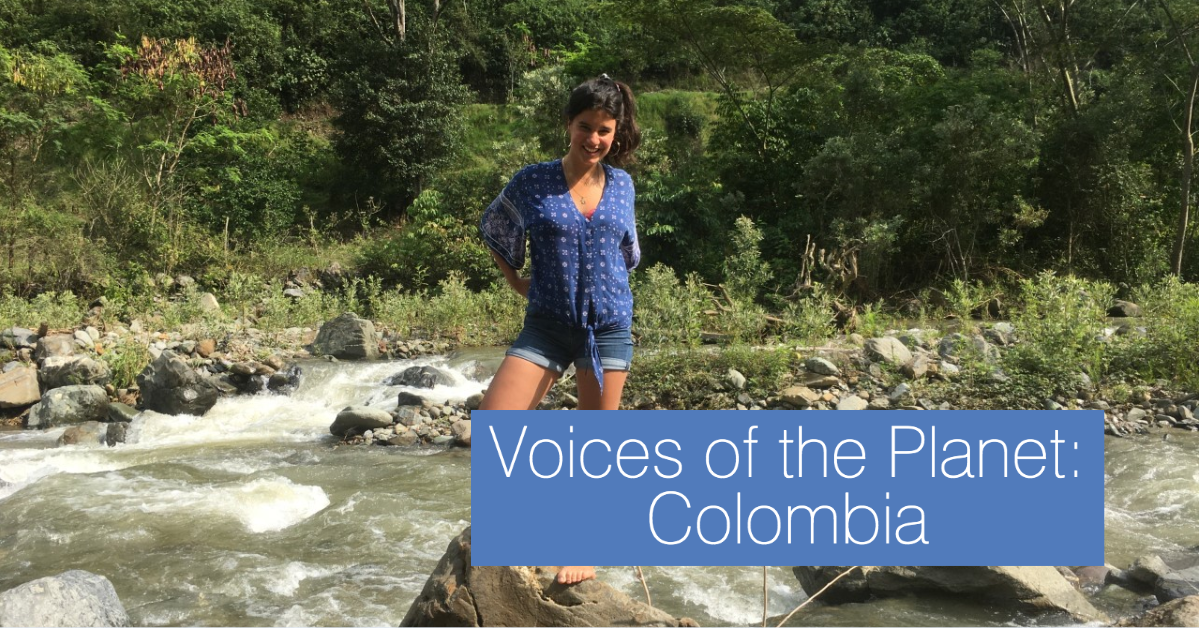
Our Voices of the Planet series highlights the real-life impacts of the climate crisis on our University community, focusing on those from the global south. In this entry, we hear from Ecological and Environmental Sciences graduate, Serena Coccioli, about how pressure to meet global food demand is impacting rural areas of Colombia.
I find myself in the ‘Eje Cafetero’, the traditional coffee-growing region of Colombia mainly comprising of the Caldas, Risaralda and Quindío departments.
Here, farmers produce coffee at altitudes between 1,200 and 2,000 metres in steep slopes with a mixture of fruiting trees and other plants whose wood and leaves are also harvested (1). The combination of coffee and trees provides a unique agroforestry landscape that is special to this region and has provided benefits for the growing of coffee and to the livelihoods of the local people. The trees protect the steep slopes from erosion and provide a habitat for a diversity of species that is sometimes equivalent in biodiversity to forested areas (2).
The trees are also a habitat for pollinators and organisms that provide biological control of pests to the coffee plantations (3). The fallen leaves from the trees provide natural fertilisation to the soil on which the coffee grows. Some of these agroforestry systems have been converted to treeless plantations with the promise that chemical inputs will provide a higher coffee yield. It may be that this is true in the short-term, however, I do not think that this intensification of the land is going to benefit the local people in the long-term.
Taking an unsustainable direction
Changes are happening. In the interest of generating more money, the landscape has changed dramatically from what I was used to. The global demand for another fruit, and the specifically apt conditions for its growth have resulted in increased intensification of agriculture in the region. Looking across the horizon where I would see green and abundant vegetation with tall trees, I see instead a mountain criss-crossed by roads in construction. Roads cut through purely in the interest of collecting and transporting this new and intensely managed monocrop – the avocado. Almost all the harvest is exported to Europe and USA. Since 2017, with a new enticing market for avocados becoming open to the US, Colombia began a supply chain riddled with strict regulations that require the use of chemical pesticides and fertilisers on the avocado monocultures (4).
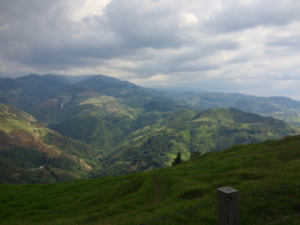
Avocado plantations are to the left and right of a naturally forested steep valley. The ‘finca’ (farm) owners have sold their land to the international companies to harvest the Hass avocado monocrop. The roads that are being constructed to transport the harvest create an arid criss-cross pattern on the mountainside.
These plantations are for the Hass variety of avocado. The fruit’s appearance is small and dark with wrinkled skin in contrast to the local variety which is larger in size, bright green and smooth skinned. Some farmers have eagerly accepted the considerable sums of money offered by the international avocado companies and have sold their land. Others have reacted negatively to the damage to their cultural landscape.
From the government’s perspective, this new market has improved the local economy. Despite the seemingly positive financial gains, it is an example of the negative side of ‘globalisation’ with social irresponsibility and disregard for the local environment. This is a unique landscape where coffee has been traditionally grown for over 100 years. The ‘Paisaje Cultural Cafetero de Colombia’ (Coffee Cultural Landscape of Colombia) became a UNESCO World Heritage site in 2011 but seems to be ignored by multinationals and under appreciated by the Colombian government (5)(6).
The local avocado variety is large with a smooth skin that is shiny and light green. This is in contrast to the exported Hass avocado variety which is smaller in size with wrinkled skin and a darker colour.
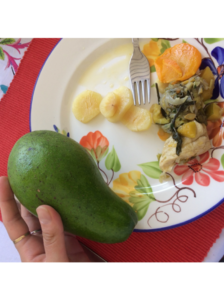
Pictured is a lunch meal of local parsnips and onion, chicken from the family farm and home grown squash, carrot and spinach.
Climate change and intensive agriculture
In the ‘Eje Cafetero’ there have been cyclical weather phases throughout the year with periods of tropical rain and periods of sunshine and heat, until recently. Now, people speak of the weather as ‘unpredictable’ and ‘extreme’ with negative consequences on growing traditional crops. During the month and a half that I have been here, there have been raging winds uncharacteristic of this time of year. I have been told by family and the local farmers that the hot ‘season’ is getting hotter resulting in drying crops, soils and river tributaries. I have been told the rains are more extreme and are accompanied by unusually high force winds. The weather is changing. People are forced to adapt to the unpredictability of this unusual climate yet farmers do not necessarily know what steps to take for adaptation (7).
So what is the connection between climate change and the avocado plantations here? Without the protection from trees and whilst the avocados grow, the slopes are highly susceptible to erosion throughout the dry and wet extremes that have been experienced much more unpredictably across the country (2). To ensure exportation standards are met and that there is rapid growth to harvest the Hass avocado, the use of artificial pesticides and fertilisers is common practice. In the long-term, this will reduce the soil’s natural fertility and will render it less able to sustain crops for some time. The soil organic carbon decreases and as a consequence the soil is less effective in sequestering carbon dioxide which further exacerbates climate change (8).
Studies have already demonstrated the negative environmental impacts from agricultural intensification in the ‘cafetales’ (coffee plantations). The agroforestry coffee systems (commonly known as ‘shade coffee’) protect the soil from erosion, conserve biodiversity, preserve yields during temperature extremes and improve soil quality over time (9)(10). The monocrop plantations of coffee (commonly known as ‘sun coffee’) are more susceptible to soil erosion, land degradation, a downgraded soil quality and reduced yields (9)(10). In the sun coffee systems, the reliance on chemical inputs to increase yield will have long-term negative effects on the local environment. This dynamic not only leaves the people less prepared to adapt to climate change, it also reduces their ability to mitigate it.
The local traditional approach to growing coffee alongside trees, helps people’s subsistence and enables them to adapt better to the changing climate (8). International corporations, on the other hand, tend to focus on short-term profits. Once productivity stops they are able to move on to other land without internalising their environmental and social costs. A vision of the long-term is missing.
The intensification of coffee has resulted in negative environmental impacts which seem to be overlooked in order to welcome the profits from the new avocado monocrop plantations. Have the lessons not been learnt?
Final thoughts
The costs are too great. The social cost of people’s traditional agriculture being undermined, especially in these uncertain times, is also putting at risk the ability to mitigate and adapt to climate change. Whilst some local farmers are taking advantage of the money offered by the new avocado multinationals, there is no compensation for the long-term environmental costs of soil infertility, soil erosion and contamination of the land and rivers by chemical inputs.
The goal of receiving money in exchange of land may be something that sounds enticing right now, however, in a few year’s time it could be that that very same money will not be able to buy something local, natural and nutritious as it once did.
I put into question that this direction of intensification of the land is going to benefit the local people, as the government says. Should we not be prioritising the self-sufficiency of the local people, incentivising them to care for the land and ensure its sustainable production of traditionally available foods?
It is also up to us. As consumers, we create the demand for these intensive agribusinesses. It is the time, now more than ever, for us to make better choices for the planet and ourselves. It is time to look at where we buy our food and how we grow it. Now is the time to align our actions and our spending with our values.
Follow Serena on Instagram for more!
References
(1) Soto-Pinto, L., Perfecto, I., Castillo-Hernandez, J. and Caballero-Nieto, J. (2000). ‘Shade effect on coffee production at the northern Tzeltal zone of the state of Chiapas, Mexico.’ Agriculture, Ecosystems & Environment, 80(1-2), 61-69.
(2) Sepúlveda, R.B. and Carrillo, A.A. (2015). ‘Soil erosion and erosion thresholds in an agroforestry system of coffee (Coffea arabica) and mixed shade trees (Inga spp and Musa spp) in Northern Nicaragua.’ Agriculture, Ecosystems & Environment, 210, 25-35.
(3) Scheper, A.C. (2019). ‘The potential of coffee agroforestry systems to enhance crop productivity, pest control, carbon sequestration and biodiversity: Evidence from the Eje Cafetero, Colombia’ (Master’s thesis at Utrecht University).
(4) ProColombia. (2018). Colombia es el nuevo proveedor ‘estrella’ de aguacate hass para el mundo [online]. Accessible at: https://procolombia.co/noticias/colombia-es-el-nuevo-proveedor-estrella-de-aguacate-hass-para-el-mundo [Last Accessed: 19/03/20].
(5) Ramirez, S.Q., Sánchez, B.M., Jimenez, S.C., Castañeda, W.R. and Ramirez, D.G. (2019). ‘Avocado and Coffee Supply Chains Specialization in Colombia.’ Procedia Computer Science, 158, 573-581.
(6) PCCC – Paisaje Cultural Cafetero de Colombia. (2017). Esencia Centro de Patrimonio Munidal [online]. Accessible at: http://paisajeculturalcafetero.org.co/contenido/zonas-del-pcc [Last Accessed 25/03/20].
(7) Lambert, N., and Eise, J. (2020). ‘Farming in the Face of Uncertainty: How Colombian Coffee Farmers Conceptualize and Communicate Their Experiences With Climate Change.’ International Journal of Communication, 14:21.
(8) van Rikxoort, H., Schroth, G., Läderach, P. et al. (2014). ‘Carbon footprints and carbon stocks reveal climate-friendly coffee production.’ Agron. Sustain. Dev. 34, 887–897. Accessible at: https://doi.org/10.1007/s13593-014-0223-8.
(9) De Souza, H. N., de Goede, R. G., Brussaard, L., Cardoso, I. M., Duarte, E. M., Fernandes, R. B., Gomes, L. C., & Pulleman, M. M. (2012). ‘Protective shade, tree diversity and soil properties in coffee agroforestry systems in the Atlantic Rainforest biome.’ Agriculture, Ecosystems & Environment, 146(1), 179-196.
(10) Perfecto, I., & Vandermeer, J. (2015). Coffee agroecology: a new approach to understanding agricultural biodiversity, ecosystem services and sustainable development. New York: Routledge.
Avocado consumption increase and its economic benefits in rural Colombia from the point of view of an agrochemical corporation: https://www.adama.com/en/our-commitment/global-farming/farming-stories/boom-in-avocados-is-reshaping-colombia-s-coffee-landscape
Further reading
A long-term view of agriculture in Colombia with climate change: Ramirez-Villegas, J., Salazar, M., Jarvis, A., & Navarro-Racines, C. E. (2012). ‘A way forward on adaptation to climate change in Colombian agriculture: Perspectives towards 2050.’ Climatic Change, 115(3– 4), 611–628.
The presence of trees is not the only important factor for the sustainability of coffee: Bosselmann, A.S., Dons, K., Oberthur, T., Olsen, C.S., Ræbild, A. and Usma, H. (2009). ‘The influence of shade trees on coffee quality in small holder coffee agroforestry systems in Southern Colombia.’ Agriculture, ecosystems & environment, 129(1-3), 253-260.
Thinking about local people not just the country’s GDP: A. and Brooks, A. (2019). ‘Who is left behind in global food systems? Local farmers failed by Colombia’s avocado boom.’ Environment and Planning E: Nature and Space, 2(2), 348-367.
New research on the use of fungi to improve soil sustainability in avocado plantations: Tamayo-Vélez, Á. and Osorio, N.W., 2018. Soil fertility improvement by litter decomposition and inoculation with the fungus Mortierella sp. in avocado plantations of Colombia. Communications in Soil Science and Plant Analysis, 49(2), pp.139-147.


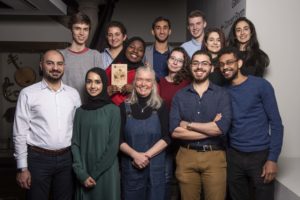
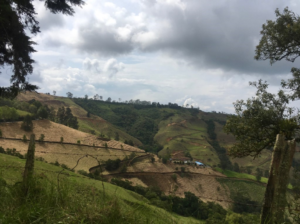


Recent comments